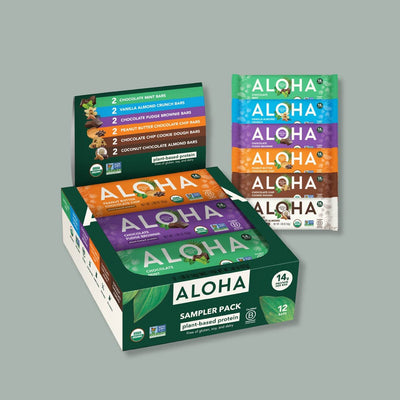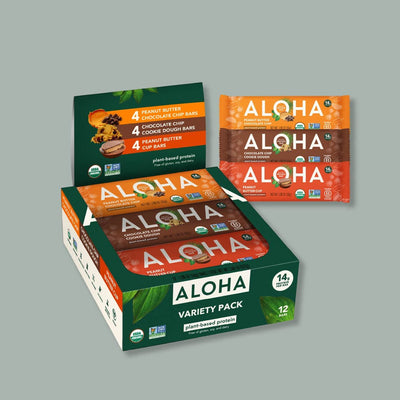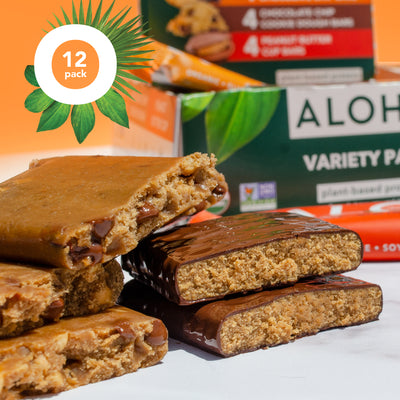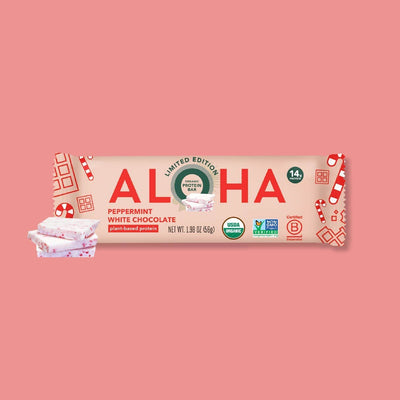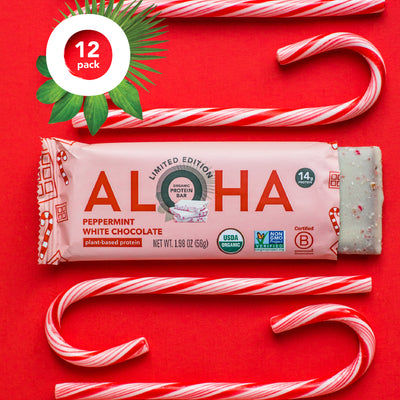Key Takeaways:
- Caffeine Comes from Cocoa Solids: Caffeine in chocolate is found in cocoa solids, not cocoa butter. Since white chocolate only contains cocoa butter, it usually doesn’t have caffeine.
- Check the Label for Mix-Ins: Some white chocolate products include added ingredients like dark chocolate or coffee flavors. Reading labels helps avoid unexpected sources of caffeine.
- All White Chocolate Isn’t the Same: Ingredients can vary depending on the brand. Choosing products from trusted, transparent brands helps avoid surprises.
Is white chocolate just chocolate without the buzz? Its creamy texture and mellow flavor don’t exactly scream “caffeine,” but assumptions can be misleading. Many people lump all chocolate into one category, but the rules change when it comes to white chocolate, bringing up a lot of curiosity around what’s inside.
At ALOHA, we make plant-based protein bars with ingredients that speak for themselves. As a Certified B Corporation, we’re committed to high standards of transparency, sustainability, and quality. Our bars are vegan, organic, and non-GMO—no guesswork, no gimmicks, just snacks you can feel good about.
In this piece, we’ll unpack the truth about white chocolate and caffeine, bust some common myths, and highlight how you can snack smart without compromising your values.
What Is White Chocolate Made Of?
White chocolate is often grouped with milk and dark chocolate, but its makeup tells a different story. Unlike traditional chocolate, which includes both cocoa butter and cocoa solids (the part that delivers the deep, rich chocolate flavor), white chocolate skips the solids entirely. Instead, it's made using cocoa butter—the natural fat from cocoa beans—blended with sugar and milk solids, and sometimes vanilla is added for a smooth texture.
This distinction is more than technical—it gives white chocolate its unique look and taste. White chocolate has a pale ivory color without cocoa solids and a noticeably sweeter, creamier flavor. There’s no bitterness or intensity like in darker chocolates, making it a favorite for those who prefer a milder treat.
Because white chocolate contains only cocoa butter and no cocoa powder or chocolate liquor, it behaves differently when it comes to certain components, like caffeine. Understanding what goes into white chocolate is the first step in uncovering whether it carries the same caffeine content as its darker relatives.
Does White Chocolate Have Caffeine?
The short answer: typically, no. Unlike milk or dark chocolate, which both contain varying levels of caffeine due to the presence of cocoa solids, white chocolate is made without them. Since caffeine is naturally found in those cocoa solids, not in the cocoa butter itself, white chocolate is generally considered caffeine-free.
That said, the keyword here is “generally.” While pure white chocolate made with just cocoa butter, milk solids, and sugar is unlikely to contain any caffeine, there are exceptions. Some products labeled as white chocolate may include small traces of cocoa solids for flavor or color, which could introduce minimal caffeine. However, white chocolate remains caffeine-free in most standard formulations, especially those made by reputable brands focused on clean ingredients.
So, if you're reaching for a white chocolate treat and are sensitive to caffeine or simply trying to avoid it, the odds are in your favor. Just check the label if you want to be 100% sure. White chocolate can often be a safe and satisfying choice for those looking to enjoy something sweet without the caffeine kick.
How It Compares: White Chocolate Vs. Milk And Dark Chocolate
Understanding the difference in caffeine content across chocolate types starts with knowing what goes into each one. While they may all come from the same plant, the ingredients and processing techniques create distinct flavors and caffeine levels. Here’s how white chocolate stacks up against milk and dark chocolate:
Dark Chocolate: The Most Caffeinated Of The Bunch
Dark chocolate contains the highest percentage of cocoa solids, which are its main caffeine source. The darker the chocolate, the more solids and the more caffeine it likely contains. This makes dark chocolate a strong option for those looking for an energy boost but less ideal for caffeine-sensitive individuals.
Milk Chocolate: A Milder Middle Ground
Milk chocolate uses fewer cocoa solids than dark chocolate and blends them with milk powder or condensed milk. Because of this dilution, it contains less caffeine than dark chocolate but still more than white chocolate. Its creamy texture and balanced sweetness make it a popular choice, though it’s not caffeine-free.
White Chocolate: Sweet, Smooth, And Usually Caffeine-Free
White chocolate skips cocoa solids entirely and relies on cocoa butter for its base. Since caffeine is found in the solids, not the butter, white chocolate typically contains little to no caffeine. This makes it a go-to option for those avoiding stimulants but still wanting something indulgent.
Why Caffeine Content Matters For Health-Conscious Consumers
Caffeine might be a daily ritual for some, but for others, it’s something to manage carefully, especially when it shows up in unexpected places. For those who prioritize clean ingredients and mindful eating, knowing where caffeine might sneak in can help guide better snack choices. Here’s why paying attention to caffeine levels in chocolate matters:
Awareness Around Daily Intake
Many health-conscious consumers track their caffeine intake from coffee or tea, but don’t always account for the caffeine in foods like chocolate. Even small amounts from snacks can add up over a day. That’s why knowing whether your treat contains caffeine is useful, even just a few milligrams.
Caffeine Sensitivity And Personal Preferences
Some people experience side effects like restlessness or trouble sleeping, even with low doses of caffeine. In these cases, avoiding hidden sources—like darker chocolates—becomes a matter of comfort. White chocolate offers a gentler alternative for those looking to enjoy sweets without the risk of stimulation.
Choosing Snacks That Align With Lifestyle Goals
Mindful of ingredients is part of making snack decisions that align with plant-based or clean-label lifestyles. This includes being informed about whether a food includes caffeine, especially if it doesn’t seem like an obvious source. For those who want to minimize stimulants, reading labels and understanding the chocolate spectrum helps make confident choices.
How To Identify Caffeine-Free Chocolate Products
Not all chocolate is created equal, and neither is the caffeine content. Knowing how to read packaging and understand what ingredients to look for is key for those who want to steer clear of caffeine completely. Here’s how to spot truly caffeine-free chocolate products:
- Look for the Absence of Cocoa Solids: Cocoa solids are where caffeine naturally occurs, so a product that includes cocoa powder, chocolate liquor, or cocoa mass likely contains caffeine. White chocolate, which is made from cocoa butter and not cocoa solids, is usually caffeine-free. Always check the ingredients list to confirm that no solids are present.
- Read Labels for Transparent Ingredient Lists: Brands that value transparency will list what’s inside, especially if the product is marketed as plant-based or clean. A short, recognizable ingredient list is a good sign that you know exactly what you’re getting. Look out for vague or overly complex terms that could hide sources of caffeine.
- Be Mindful of Flavor Additions and Mix-Ins: Even if a product is labeled as white chocolate, added ingredients like chocolate chips or cocoa nibs could introduce caffeine. Some bars or snacks mix dark chocolate elements for taste or texture, changing the caffeine profile. When in doubt, check if these extras are present before assuming it’s caffeine-free.
- Check for Product Certifications and Brand Values: Brands prioritizing clean, simple ingredients often clarify what's inside their products, including whether caffeine is present. Certifications like organic, vegan, or non-GMO don't guarantee a product is caffeine-free, but they can indicate that the brand is committed to transparency. Choosing products from companies known for these values can make it easier to trust your consumption.
Is White Chocolate Safe For Caffeine-Sensitive Individuals?
Knowing what snacks are safe for anyone who experiences side effects from even small amounts of caffeine can take a lot of the guesswork out of grocery shopping. White chocolate is often recommended for caffeine-sensitive individuals, but it’s important to understand why and when it might still be worth double-checking. Here's what to keep in mind:
Naturally Low To No Caffeine
Since white chocolate is made without cocoa solids—the main source of caffeine in chocolate—it’s usually a safe pick for those who avoid stimulants. Most standard white chocolate products contain no measurable caffeine at all. That said, formulations can vary, especially in flavored or specialty varieties.
Check For Mixed Chocolate Ingredients
Some products labeled “white chocolate” include add-ins like chocolate drizzle, chips, or coatings from milk or dark chocolate. These extras, while small, can introduce trace amounts of caffeine. Scanning for these on the label is a helpful habit if you're highly sensitive.
Stick With Transparent Brands
Brands focusing on clean, simple ingredients are more likely to list what’s inside and avoid unnecessary additives. When looking for white chocolate treats, choosing a product from a transparent, trusted brand reduces the chance of hidden caffeine sources. It also supports confidence in what you’re putting into your body.
Final Thoughts
White chocolate may not deliver the jolt that dark or milk chocolate does, but that’s exactly what makes it appealing to many. Its smooth, mellow nature offers a different kind of indulgence that aligns with a more mindful approach to snacking. For those seeking a balance between enjoyment and intention, white chocolate proves you don’t need caffeine to satisfy a craving. As always, choosing snacks with clarity and purpose starts with understanding what’s inside.
Read also:
- When To Drink Protein Shakes For Weight Loss: Best Times
- What Are Protein Shakes For? Benefits And Uses Explained
- Meal Replacement Shake Recipes: Healthy & Filling Options
Frequently Asked Questions About Does White Chocolate Have Caffeine
Can caffeine show up in white chocolate from cross-contamination?
Yes, if white chocolate is produced in a facility that also handles dark or milk chocolate, trace amounts of caffeine may be present. While it's not common, cross-contamination is possible. Always check the label for allergens or shared equipment disclaimers.
Are there any caffeine-free chocolate alternatives for people who don’t like white chocolate?
Yes, chocolate-style treats made with cocoa butter blends are entirely caffeine-free. These alternatives mimic the creamy texture without using cocoa solids, making them a good option for those who avoid both caffeine and the sweeter taste of white chocolate.
Is caffeine ever added to white chocolate intentionally?
While rare, some novelty or energy-boosting products might intentionally add caffeine to white chocolate. These are typically marketed clearly as “energy bars” or “high-caffeine snacks.” If you're avoiding caffeine, always check the ingredient list for added stimulants.
Do flavored white chocolates have a higher chance of containing caffeine?
Yes, especially if the flavor includes mocha, coffee, or mixed chocolate components. These additions may introduce caffeine depending on the ingredients used. Vanilla or fruit-infused white chocolates typically remain caffeine-free.
Is cocoa butter used in other caffeine-free foods?
Yes, cocoa butter is commonly used in cosmetics and some dairy-free desserts without introducing caffeine. Since it contains no cocoa solids, it’s safe for those avoiding caffeine. It’s valued for its rich texture rather than its stimulant properties.
How much caffeine is considered “trace” in chocolate products?
Trace amounts usually mean less than 5 milligrams per serving—far below what you’d find in even a cup of decaf coffee. While insignificant for most people, even small amounts can matter for the caffeine-sensitive. It's best to err on the side of caution if needed.
Does the color of chocolate indicate caffeine content?
Not directly, but darker chocolate often contains more caffeine due to higher cocoa solid content. White chocolate’s light color reflects the absence of these solids. However, always read the label, as appearances can be deceiving with blended or coated products.
Can children safely eat white chocolate without caffeine concerns?
Yes, in most cases, white chocolate is safe for children when caffeine is a concern. Still, it’s good practice to check the ingredients, especially for novelty or mixed chocolate items. Some parents prefer to avoid any caffeine exposure, even in tiny amounts.
Are there any regulations about labeling caffeine in chocolate?
Labeling laws vary by region, and many products are not required to state caffeine content unless added separately. Most chocolate items don’t include caffeine data unless it's a key selling point. That’s why reading the full ingredient list is always recommended.
What makes ALOHA’s Raspberry White Chocolate Bar a mindful choice?
ALOHA focuses on simple, plant-based ingredients with no hidden additives or surprises. Their Raspberry White Chocolate Protein Bar uses organic ingredients and doesn’t rely on caffeine to boost energy. It’s a clean-label snack option for those mindful of what they eat.
Sources:
1. Smith, A. P. (2021). Caffeine, chocolate, performance, and mood. World Journal of Pharmaceutical and Medical Research, 10(14), 180–188. https://doi.org/10.20959/wjpr202114-22277
2. Marcucci, M. C., Silva, A. G. F. da, Goncalves, C. P., Sawaya, A. C. H. F., Alonso, R. C. B., Oliveira, M. M. de, & Barbin, D. F. (2021). Quality Parameters, Caffeine and Theobromine Contents and Antioxidant Activity of Artisan and Commercial Chocolate from Brazil. OALib, 08(05), 1–18. https://doi.org/10.4236/oalib.1107377
3. Ramli, N., Rahman, S., Hassan, O., Yatim, A., Said, M., Luan, L., Ng, S., & Fong, W. (2000). Caffeine and Theobromine Levels in Chocolate Couverture and Coating Products. Mal J Nutr, 6, 55–63. https://citeseerx.ist.psu.edu/document?repid=rep1&type=pdf&doi=66850771f7253fb7030f4a41faecb82907e0c9e4
4. Richards, A., & Wailes, B. (2012). Estimation of Fat-Free Cocoa Solids in Chocolate and Cocoa Products -Global Survey of Typical Concentrations of Theobromine and Caffeine Determined by HPLC. Journal of the Association of Public Analysts, 40, 1–12. http://www.apajournal.org.uk/2012_0001-0012.pdf
ALOHA's products are not intended to treat, diagnose, mitigate, prevent, or cure disease. ALOHA's products should not replace prescribed medications or the variety of foods important to a healthful diet.
Do not self-diagnose any health condition. Work with your healthcare provider to determine how best to achieve optimal health.





